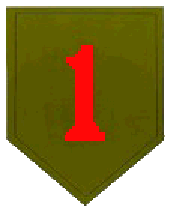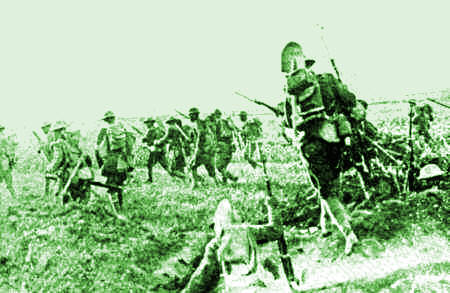The Story of the American Expeditionary Forces |

1st Division |
CANTIGNYFIRST BATTLE OF THE AEF |

The 28th Infantry goes over the top at Cantigny

|
| A First Hand Account |
Quick Facts
 Moving UpBackgroundAs the third spring offensive of the German Army was getting underway along the Aisne River, the first American attack of the war took place to the west at Cantigny, a village near Montdidier in the Somme region. It had fallen to the enemy Eighteenth Army during the first spring offensive in March. The 1st Division was moved to the sector in late April. The Germans spent most of the month of May enthusiastically pounding the Yanks with artillery and gas. It was only learned afterwards that Ludendorff had ordered any new American formations singled out for 'special treatment'. After bearing up well under its nightly initiation rite, the Division was ordered to take highly fortified Cantigny to test its offensive capabilities. The town was captured on the first day of the assault (28 May) with the Division's 28th Infantry Regiment in the lead. After taking over 200 prisoners, the Americans withstood a series of strong counterattacks which died out during nextt two days. The victors suffered 1,603 casualties including 199 killed. Although Cantigny was a local operation, it boosted Allied morale to see the AEF finally on the offensive. With the deployment of the 2nd and 3rd divisions to the defense of Chateau-Thierry quickly following this small victory, the German high command were shown that the long feared American infusion of manpower was becoming a reality. Source: "Cantigny" in: AN ILLUSTRATED COMPANION TO THE FIRST WORLD WAR, Anthony Bruce.
 Major Gen. Robert L. Bullard, 1st Division Commander at CantignyHow It Looked to the BrassTHE ATTACK The 28th Infantry attacked CANTIGNY at 6:45am, May, 28, 1918, after violent artillery preparation of one hour. The regiment advanced in three lines. The first line closed in to within forty to fifty yards of the barrage, which progressed at the rate of 100 meters in two minutes. The second line rapidly closed on the first line in order that all elements would be 200 yards from the old front line at H plus 10 minutes. This was done to lessen casualties should an enemy's barrage be put down. The third line conformed to the advance. The objective was reached as per schedule at 7:20am. Patrols were immediately pushed forward and automatic rifle posts were established in shell holes on the line of surveillance to cover the consolidation. The second line, which advanced, consolidated with a line of trenches and wired the line of resistance. The third line, on it's arrival, began the consolidation of three strong points, one about 200 meters east of the chateau in CANTIGNY, the second in the woods at the northeastern exit of CANTIGNY, and the third at the cemetery just north of CANTIGNY. "D" company of the 1st Engineers supervised the consolidation of these strong points and the lines of surveillance and resistance. Throughout, the attack progressed with slight resistance and with practically no reaction on the part of the enemy artillery. The section of French flame throwers proved invaluable in cleaning up the town of CANTIGNY and driving the enemy out of dugouts. During the cleaning up of CANTIGNY, our troops were engaged in minor fights, but for the most part, the objective was gained with rapidity and with considerable ease.  AdvancingNot before noon did the enemy artillery and machine gun fire become heavy. From this time on and during the 72 hours following, the positions about CANTIGNY were heavily shelled both by large and by small caliber guns. Enemy machine gun fire was also heavy. At 7:30am, a small enemy infantry counter-attack was reported to have been delivered without success against the BOIS FONTAINE. At 5:10pm, the enemy launched from the western tip of the BOIS FRAMICOURT another counter-attack. This was broken up by our artillery. The attack was followed at 6:45pm, after a heavy preparation and barrage fire, by enemy infantry advancing in several waves from the southern and western edges of the BOIS FRAMICOURT. The first wave succeeded in getting through before our barrage was put down. It was driven back by infantry fire, and the following waves were smothered by artillery fire. During the night of May 28-29, the two companies of the 18th Infantry in reserve were ordered into the operation by the C.G., 2nd Brigade to support the 28th Infantry. One battalion of the 18th Infantry in the vicinity of VILLERS-TOURNELLE, was ordered to take position in rear of the southwest corner of the BOIS DES GLANDS. The other battalion of the 18th Inf., in the vicinity of VILLERS-TOURNELLE was assembled and held in readiness.
MAY 29TH Between 6:00am, and 7:00am, the enemy launched two small counter-attacks which were quickly broken up by artillery. At 5:45pm, the enemy launched its second heavy counter-attack. Left elements of the 28th Inf. drew back slightly, but the remainder of the line withstood the attack. Artillery and infantry fire broke up this assault.  Cleaning-UpMAY 30TH At 5:30am, the enemy made his final counter-attack. It was preceded by a barrage of heavy preparation fire. The enemy attacked in two waves from the LALVAL wood. This attack was also broken up by rifle, machine gun and artillery fire. In all, seven enemy counter-attacks were reported as launched against our troops. Three of these attacks appeared to have been made by at least a battalion of infantry. The first was the most determined and fell principally on the center battalion, and the right of the left battalion, and was preceded by a preparation fire of 150mm and 77mm shells. The enemy followed this barrage from 125 to 200 yards, thus enabling our troops to be in full readiness after the barrage had passed them. After the morning of May 30th, the enemy activity lessened. This enabled a greater part of the 28th Infantry to be relieved by the 16th Infantry on the night of May 30-31st. The following night the remainder of the regiment was relieved and the command of the sector passed to the C.O. 16th Infantry. Prepared by Major General E.F.McGlachlin, Jr., Commanding General, 1st Div., in the Army of Occupation:
 German PrisonersHow It Looked To A DoughboyInto the village of Cantigny we go. There remained nothing but ruins. We passed on through to the other side of the village. Here we encountered barbed wire entanglements but it was our good fortune to get through these without any mishap. But once across I notice that the boys are falling down fast. A shell burst about ten yards in front of me and the dirt from the explosion knocked me flat on my back. I got up again but could not see further than one hundred feet. I heard someone yell "lay down." I knelt on one knee and wondered what would come next...We laid down and started to shoot and it was our good fortune that the second wave reached the place at this time. About twenty Dutchmen came out of the holes, threw down their rifles and stood with their hands up. The doughboys didn't pay any attention to this but started in to butcher and shoot them. One of the doughboys on the run stabbed a Dutchman and his bayonet went clear through him... The German artillery was in action all the time...I stopped at a strong point and asked the boy in the trench if there was room for me to get in. "Don't ask for room, but get in before you get your [!#%&] shot off," a doughboy said... We stayed there all that night and the next day, being relieved at two o'clock the following morning, taking position in the first line of reserve trenches. We ate a cooked dinner at eleven o'clock, that being the first meal we've had in three days. Sgt. Boleslaw Suchocki, 28th Infantry, 1st Division
Michael E. Hanlon (medwardh@hotmail.com) regarding content, or toMike Iavarone (mikei01@execpc.com) regarding form and function. Original artwork & copy; © 1998-2000, The Great War Society |
